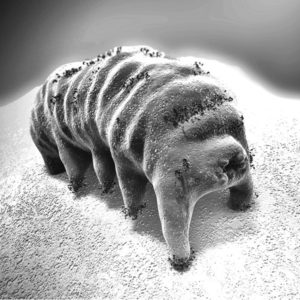 Everyone has their favorite microscopic creature—you all do have a favorite, right? Mine is unquestionably the tardigrade. Tardigrades, also called water bears or moss piglets, are microscopic invertebrates that are composed of five segments: one head segment and four body segments, each with a pair of legs. They are 0.1–1.2mm in length, making them easy to see under low magnification, and have a brain and well-developed nervous system. Tardigrades are found in just about every environment on earth. Termed “extremophiles”, they have adapted to survive in even extremely harsh environments. Your neighborhood pond? The Himalayas? Antarctica? Deep sea? Tardigrades live in all those places.
Everyone has their favorite microscopic creature—you all do have a favorite, right? Mine is unquestionably the tardigrade. Tardigrades, also called water bears or moss piglets, are microscopic invertebrates that are composed of five segments: one head segment and four body segments, each with a pair of legs. They are 0.1–1.2mm in length, making them easy to see under low magnification, and have a brain and well-developed nervous system. Tardigrades are found in just about every environment on earth. Termed “extremophiles”, they have adapted to survive in even extremely harsh environments. Your neighborhood pond? The Himalayas? Antarctica? Deep sea? Tardigrades live in all those places.
Although many of us fell in love with these microscopic animals the first time we saw them—because there is no denying that they are darn cute— there are other good reasons why scientists are so fascinated by these creatures. Tardigrades are incredibly resilient. And by resilient, I mean almost indestructible. All tardigrades require water to grow and to reproduce. However, when the water disappears, some species can lose almost all of their body water and enter a state of near dehydration called anhydrobiosis. In this metabolically inactive state, tardigrades can survive any number of extreme conditions. They can survive freezing (–273°C), extreme heat (~100°C), high doses of irradiation, immersion in organic solvents, and even the vacuum of space (1). They can remain in this state for years—a tardigrade was revived after spending 30 years frozen in the anhydrobiosis state.

How tardigrades are able to survive under all these conditions is something scientist are still trying to understand, but recent genome sequencing studies have begun to shed some light on the mechanisms these animals use. When looking at exposure to high doses of ionizing radiation, the genome of the highly radiation-tolerant tardigrade species, Ramazzottiuts variornatus, identified a tardigrade-unique DNA associating protein, Dsup, which scientists believe is involved in the process tardigrades use to keep their DNA from fragmenting. When human-culture cells expressing Dsup are irradiated, they do not experience the level radiation-induced breaks in their DNA that normal cells do (2). This protection is evident in cells before they have a chance to repair DNA damage, leading scientist to believe that the Dsup protein acts as DNA protective protein that stops the damage from occurring rather than a DNA repair protein that fixes damage after it occurs.
It is noteworthy that there are some species of tardigrades that are highly radio tolerant even in the hydrated state. These tardigrades, unlike other desiccation-tolerant animals, also do not experience the dehydration stress DNA damage that other animals do. The genome studies revealed that tardigrades have developed and express many tardigrade-unique genes (3). While the Dsup gene binds itself to DNA and appears to protect it, tardigrades also possess more copies of both an anti-oxidant enzyme and a DNA-repair gene. Both of these could help tardigrades recover from the oxidative stress of dehydration and likely from DNA damage resulting from other causes.
Clearly tardigrades have evolved unique ways to survive in extreme environments. Study these adaptations can help us understand how these creatures survive under seemingly unsurvivable conditions. Identifying and understanding these tolerance genes and mechanism could lead to ways to confer these protections to other plants and animals.
Tardigrades are survivors. Their ability to survive in such extreme conditions is a testimony to the wonder and power of nature. Is it any wonder that they are my favorite microscopic creature? Do you have a favorite microorganism? I would love to hear your argument as to why they are cooler than tardigrades.
References
- Hashimoto, T. and Kunieda, T. (2017) Life 7, 26.
- Hashimoto, T. et al. (2016) Nat. Commun. Sep 20;7, 12808.
- Yoshida, Y. et al. (2017) PLOS Biol. Jul 27;15(7), e2002266
Kelly Grooms
Latest posts by Kelly Grooms (see all)
- Avoid the Summertime Blue-Greens— Know about Cyanobacteria Before You Hit the Water - July 8, 2025
- Growing Our Understanding of Triple-Negative Breast Cancer in Sub-Saharan Africa: Why Comprehensive Population Data Matters - June 5, 2025
- Measles and Immunosuppression—When Getting Well Means You Can Still Get Sick - April 17, 2025
